編輯:關於Android編程
本文實例講述了Android編程實現自定義輸入法功能。分享給大家供大家參考,具體如下:
對於Android用戶而言,一般都會使用第三方的輸入法。可是,在輸入密碼時(尤其是支付相關的密碼),使用第三方輸入法有極大的安全隱患。目前很多網銀類的APP和支付寶等軟件在用戶輸入密碼時,都會彈出自定義的輸入法而不是直接使用系統輸入法。
這裡介紹的就是如何實現一個簡單的自定義輸入法。當然,也可以自己寫一個Dialog加上幾十個按鈕讓用戶輸入,只不過這樣顯得不夠專業。
(一)首先上效果圖:
1.前面兩個輸入框使用了自定義的輸入法:

2.第三個輸入框沒有進行任何設置,因此將使用默認的輸入法:

(二)代碼簡介:
1.主頁面布局,由3個輸入框加上一個android.inputmethodservice.KeyboardView組成。android.inputmethodservice.KeyboardView是一個系統自帶的繼承自View的組件,但是它不在android.view這個包下面,因此這裡需要寫上完整的包名。
<RelativeLayout xmlns:android="http://schemas.android.com/apk/res/android"
android:layout_width="match_parent"
android:layout_height="match_parent">
<!--前兩個EditText均使用自定義的輸入法-->
<EditText
android:id="@+id/input_password"
android:layout_width="match_parent"
android:layout_height="wrap_content"
android:layout_margin="8dp"
android:hint="one password"
android:layout_alignParentTop="true"
android:inputType="textPassword" />
<EditText
android:id="@+id/input_password2"
android:layout_width="match_parent"
android:layout_height="wrap_content"
android:layout_below="@+id/input_password"
android:layout_margin="8dp"
android:hint="another password"
android:inputType="textPassword" />
<!--這個EditText使用默認的輸入法-->
<EditText
android:id="@+id/input_normal_text"
android:layout_width="match_parent"
android:layout_height="wrap_content"
android:layout_below="@+id/input_password2"
android:layout_margin="8dp"
android:hint="normal text" />
<android.inputmethodservice.KeyboardView
android:id="@+id/keyboardview"
android:layout_width="match_parent"
android:layout_height="wrap_content"
android:layout_alignParentBottom="true"
android:layout_centerHorizontal="true"
android:focusable="true"
android:focusableInTouchMode="true"
android:visibility="gone" />
</RelativeLayout>
2.KeyboardView是一個顯示輸入法的容器控件,使用時需要設置具體的輸入法面板內容。
(1)首先在res下新建xml目錄,然後創建文件keys_layout.xml,即輸入法面板的內容。每個row表示一行,Keyboad的屬性keyWidth和keyHeight表示每個按鍵的大小,25%p表示占父組件的25%. Key的屬性codes表示該按鍵的編號(點擊時系統回調方法中會返回這個值,用以區分不同的按鍵),keyLabel表示按鍵上面顯示的文字。還有很多其它的屬性,不再陳述。
<?xml version="1.0" encoding="utf-8"?>
<Keyboard xmlns:android="http://schemas.android.com/apk/res/android"
android:keyWidth="25%p"
android:keyHeight="10%p">
<Row>
<Key
android:codes="55"
android:keyLabel="7"
android:keyEdgeFlags="left" />
<Key
android:codes="56"
android:keyLabel="8" />
<Key
android:codes="57"
android:keyLabel="9" />
<!--刪除按鍵長按時連續響應-->
<Key
android:codes="60001"
android:keyLabel="DEL"
android:isRepeatable="true" />
</Row>
<Row>
<Key
android:codes="52"
android:keyLabel="4"
android:keyEdgeFlags="left" />
<Key
android:codes="53"
android:keyLabel="5" />
<Key
android:codes="54"
android:keyLabel="6" />
<Key
android:codes="48"
android:keyLabel="0" />
</Row>
<Row>
<Key
android:codes="49"
android:keyLabel="1"
android:keyEdgeFlags="left" />
<Key
android:codes="50"
android:keyLabel="2" />
<Key
android:codes="51"
android:keyLabel="3" />
<Key
android:codes="60002"
android:keyLabel="Cancel" />
</Row>
</Keyboard>
(2)為了使用方便,新建一個類:KeyboardBuilder.java,用於初始化自定義輸入法和綁定EditText,代碼如下:
public class KeyboardBuilder {
private static final String TAG = "KeyboardBuilder";
private Activity mActivity;
private KeyboardView mKeyboardView;
public KeyboardBuilder(Activity ac, KeyboardView keyboardView, int keyBoardXmlResId) {
mActivity = ac;
mKeyboardView = keyboardView;
Keyboard mKeyboard = new Keyboard(mActivity, keyBoardXmlResId);
// Attach the keyboard to the view
mKeyboardView.setKeyboard(mKeyboard);
// Do not show the preview balloons
mKeyboardView.setPreviewEnabled(false);
KeyboardView.OnKeyboardActionListener keyboardListener = new KeyboardView.OnKeyboardActionListener() {
@Override
public void onKey(int primaryCode, int[] keyCodes) {
// Get the EditText and its Editable
View focusCurrent = mActivity.getWindow().getCurrentFocus();
if (focusCurrent == null || !(focusCurrent instanceof EditText)) {
return;
}
EditText edittext = (EditText) focusCurrent;
Editable editable = edittext.getText();
int start = edittext.getSelectionStart();
// Handle key
if (primaryCode == Constant.CodeCancel) {
hideCustomKeyboard();
} else if (primaryCode == Constant.CodeDelete) {
if (editable != null && start > 0) {
editable.delete(start - 1, start);
}
} else {
// Insert character
editable.insert(start, Character.toString((char) primaryCode));
}
}
@Override
public void onPress(int arg0) {
}
@Override
public void onRelease(int primaryCode) {
}
@Override
public void onText(CharSequence text) {
}
@Override
public void swipeDown() {
}
@Override
public void swipeLeft() {
}
@Override
public void swipeRight() {
}
@Override
public void swipeUp() {
}
};
mKeyboardView.setOnKeyboardActionListener(keyboardListener);
}
//綁定一個EditText
public void registerEditText(EditText editText) {
// Make the custom keyboard appear
editText.setOnFocusChangeListener(new View.OnFocusChangeListener() {
@Override
public void onFocusChange(View v, boolean hasFocus) {
if (hasFocus) {
showCustomKeyboard(v);
} else {
hideCustomKeyboard();
}
}
});
editText.setOnClickListener(new View.OnClickListener() {
@Override
public void onClick(View v) {
Log.d(TAG, "onClick");
showCustomKeyboard(v);
}
});
editText.setOnTouchListener(new View.OnTouchListener() {
@Override
public boolean onTouch(View v, MotionEvent event) {
Log.d(TAG, "onTouch");
EditText edittext = (EditText) v;
int inType = edittext.getInputType(); // Backup the input type
edittext.setInputType(InputType.TYPE_NULL); // Disable standard keyboard
edittext.onTouchEvent(event); // Call native handler
edittext.setInputType(inType); // Restore input type
edittext.setSelection(edittext.getText().length());
return true;
}
});
}
public void hideCustomKeyboard() {
mKeyboardView.setVisibility(View.GONE);
mKeyboardView.setEnabled(false);
}
public void showCustomKeyboard(View v) {
mKeyboardView.setVisibility(View.VISIBLE);
mKeyboardView.setEnabled(true);
if (v != null) {
((InputMethodManager) mActivity.getSystemService(Activity.INPUT_METHOD_SERVICE)).hideSoftInputFromWindow(v.getWindowToken(), 0);
}
}
public boolean isCustomKeyboardVisible() {
return mKeyboardView.getVisibility() == View.VISIBLE;
}
}
3.最後是主Activity的代碼,這裡就很簡單了。
/**
* 自定義安全輸入法
*/
public class MainActivity extends ActionBarActivity {
private KeyboardBuilder builder;
@Override
protected void onCreate(Bundle savedInstanceState) {
super.onCreate(savedInstanceState);
setContentView(R.layout.activity_main);
getWindow().setSoftInputMode(WindowManager.LayoutParams.SOFT_INPUT_STATE_ALWAYS_HIDDEN);
KeyboardView keyboardView = (KeyboardView) findViewById(R.id.keyboardview);
builder = new KeyboardBuilder(this, keyboardView, R.xml.keys_layout);
EditText editText = (EditText) findViewById(R.id.input_password);
builder.registerEditText(editText);
EditText editText2 = (EditText) findViewById(R.id.input_password2);
builder.registerEditText(editText2);
}
@Override
public void onBackPressed() {
if (builder != null && builder.isCustomKeyboardVisible()) {
builder.hideCustomKeyboard();
} else {
this.finish();
}
}
}
更多關於Android相關內容感興趣的讀者可查看本站專題:《Android視圖View技巧總結》、《Android開發動畫技巧匯總》、《Android編程之activity操作技巧總結》、《Android布局layout技巧總結》、《Android開發入門與進階教程》、《Android資源操作技巧匯總》及《Android控件用法總結》
希望本文所述對大家Android程序設計有所幫助。
 使用SignalR推送服務在Android的實現 SignalA
使用SignalR推送服務在Android的實現 SignalA
由於我的版本最低是2.2,所以只有把源碼下下來自己改,如果你覺得太多了可自己編譯成jar引用,本人不才,對java不是很熟悉,如果此版本中有錯誤還請大家指出來,此圖顯示的
 Android 應用程序簽名
Android 應用程序簽名
本文主要介紹Android應用程序簽名的相關理論知識以及如何發布Android應用程序。 1.簽名的概念 為大家所熟知的日常生活中的簽名,它是代表某個人的特殊標記,用
 AndroidMainfest.xml詳解——(activity)
AndroidMainfest.xml詳解——(activity)
語法: . . .包含它的文件:可包含:說明:聲明一個實現應用的部分可視化用戶界面的 Activity(一個 Activity子類)。 所有 Activity
 VideoView播放視頻初體驗
VideoView播放視頻初體驗
這幾個月一直在忙項目上的事情,所以已經有一段時間不寫博客,抽時間整理下最近的收藏夾,感覺還是有一些新的知識點可以分享的。先從最近的說起,近期項目上需要支持視頻播放功能,雖